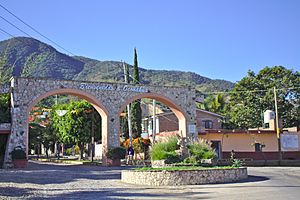Oconahua facts for kids
Oconahua is a small town in the Mexican state of Jalisco. It is part of the Etzatlán area. In 2020, about 2,360 people lived there.
Oconahua is also an important archaeological site. It is home to the Ocomo Palace, a very old and well-preserved building. This site covers a huge area, about 400 hectares (that's like 1,000 acres!). You can still see parts of terraces, sunken courts, pyramids, and platforms there. The biggest platform is about 40 by 30 feet.
Contents
Geography
Oconahua is in the western part of Jalisco. It is about 100 kilometers (62 miles) from Guadalajara, a big city. The town is 1,490 meters (about 4,888 feet) above sea level. This means it's quite high up!
Oconahua shares its borders with different places. To the north is the San Marcos area. To the south is the Puerta de Pericos area. The eastern side is next to the main part of Etzatlán. To the west, it borders the San Rafael area and the state of Nayarit.
Festival
Every September, Oconahua celebrates its town saint with a big festival. Many people enjoy the bullfighting events. There are also fun rides for everyone. A special part of the festival is the burning of a "castillo." This is a huge structure made of fireworks!
At night, a band plays music, and people dance in the town square, called the plaza. The festival starts on September 20th and lasts until the end of the month.
History
The Ocomo Palace is a very old building found in Oconahua. It is the largest and best-kept structure at the archaeological site. This palace was built a long time ago, between 900 and 1200 CE.
Experts believe the Ocomo Palace was used for managing things, not for religious ceremonies. It was also a key place for trade between different regions. Outside the palace, there were once four large stone slabs called stelae. These stelae had carvings and designs, possibly even ancient writing. Sadly, these were destroyed a long time ago.
Oconahua is a farming community. People grow crops like corn and raise animals such as chickens, pigs, and cattle. Many homes are made of brick, but some older ones are still made of adobe. Like most towns in Jalisco, Oconahua has a main square with a gazebo. To the south of the square is the town's only church, dedicated to Saint Michael the Archangel.
Moctezuma and the Aztecs
The Aztec Empire was very powerful when the Spanish arrived in 1519. Moctezuma II was the Aztec emperor at that time. He was known as a skilled warrior. He helped the Aztec Empire grow even larger.
Moctezuma conquered many lands, including the rich Xoconochco region. This area had valuable items like bright blue and green quetzal feathers, gold, jaguar skins, and cocoa beans. These were great treasures for the Aztecs, who could not find them in their own colder lands.
Moctezuma was also known for forming alliances through marriage. He married many women, often the daughters or nieces of local leaders. This helped him keep control over different regions. He had two main wives, Tezalco and Acatlán, who were very important.
Codex Mendoza
The Codex Mendoza is an ancient Aztec book. It shows all the lands that Emperor Moctezuma conquered. Sometimes, territories would rebel against the Aztecs and had to be conquered again. Because of this, their names appeared many times in these old books. For example, the area of Huexolotlan was conquered by both Emperor Ahuítzotl and Moctezuma.
Linen of Tlaxcala
The History of Tlaxcala is another important old book. It was written by Diego Muñoz Camargo around 1585. It is also known as the Lienzo Tlaxcala, which means "Linen of Tlaxcala." This book tells the religious, cultural, and military story of the Tlaxcaltec people. It especially focuses on what happened after the Spanish arrived.
The History of Tlaxcala has three main parts:
- A Spanish text that describes the city and area of Tlaxcala.
- The "Tlaxcala Calendar," which has many pictures with captions in both Spanish and Nahuatl (the Aztec language).
- The "Tlaxcala Codex," which also has many pictures and captions in Spanish and Nahuatl.
Cristóbal de Olid
Cristóbal de Olid (1487–1524) was a Spanish explorer and soldier. He was part of the Spanish conquest of Mexico. He played a role in the Jalisco region.
Olid grew up in the home of Diego Velázquez de Cuéllar, who was the governor of Cuba. In 1519, Olid sailed with Hernán Cortés and helped conquer Mexico. He fought in important battles, like the Battle of Otumba. He also fought against the Purépecha, who were tough opponents because they used iron weapons.
During the siege of Tenochtitlán, Olid had some disagreements with another Spanish leader, Pedro de Alvarado. Olid later led the conquest of the Jalisco and Colima regions in 1522. He led Spanish soldiers and their Tlaxcalan allies in these conquests.
See also
 In Spanish: Oconahua para niños
In Spanish: Oconahua para niños


